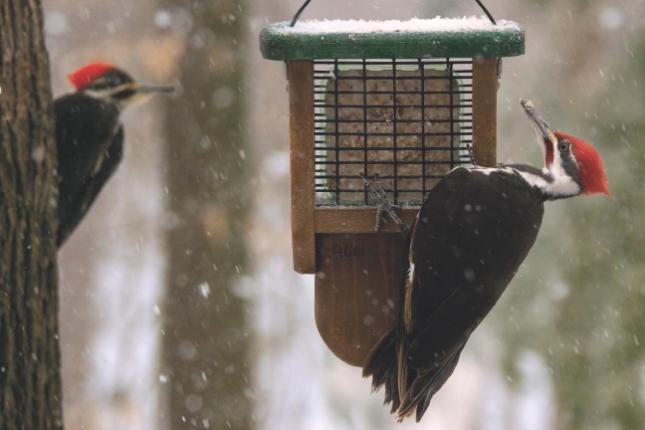
Order: Piciformes Family: Picidae (woodpecker in latin)
Scientific name: Dryocopus pileatus
Pileated Woodpecker Fun Facts
Woodpecker species are capable of exuding approximately 1,200 - 1,400 g-force units per each hit they make! That is about 12-14 TIMES more g-force units to give one grown human a concussion. However since they exude that much force, they have evolved over time to have their tongue wrap around their skull to help protect their brains from damage alongside a beak and skull structure to assist in distributing the shock from each blow.
Pileated Woodpeckers live in mature woodlands of nearly every type. They can also be found in younger forests that have dead trees or a ready supply of decaying wood. Pileated Woodpeckers can also be found in suburban areas with large trees and patches of forest.
The Pileated Woodpecker’s primary food is carpenter ants, supplemented by other ants, wood boring beetle larvae, and other insects such as flies, spruce budworm, caterpillars, and grasshoppers.
In some diet studies, ants constituted 40 percent of the diet, and up to 97 percent in some individuals. Pileated Woodpeckers also visit backyard bird feeders for seeds, peanuts, or suet.
Nest trees are typically dead and within a mature or old stand of coniferous or deciduous trees, but may also be in dead trees in younger forests or even in cities.
Dead trees are a valuable resource as nest sites or shelter for birds and other animals, and Pileated Woodpeckers battle for ownership with Wood Ducks, European Starlings and, occasionally, bats and swifts share roost cavities with Pileated Woodpeckers.
The male excavates most of the nest cavity and creates an oval hole, as opposed to the circular one made by most woodpeckers. The nest construction usually takes 3-6 weeks, and nests are rarely reused in later years.
Pileated Woodpeckers forage in large, dead wood, excavating the tunnels of ants. They also use their barbed tongues to dig out insects.
Pileated Woodpeckers are monogamous and hold large territories; it’s rare to see more than two birds together at a time.
In flight, their white underbellies are clearly visible, while they flap unevenly and undulating.
Pileated Woodpecker populations have increased from 1966 to 2014, according to the North American Breeding Bird Survey. Partners in Flight estimates a global breeding population of 1.9 million with 67% living in the U.S., and 33% in Canada.
Consider putting up a nest box to attract a breeding pair. Make sure you put it up well before breeding season. Attach a guard to keep predators from raiding eggs and young.

